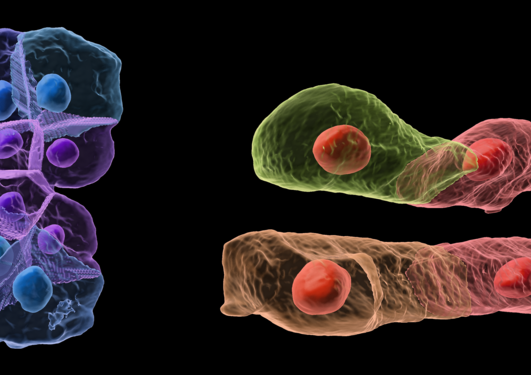Closed Ascidian facility

Main content
The Christiaen group currently houses Ciona in different aquatic facilities located in the High Technology Center in Marineholmen.
Ciona robusta and Ciona intestinalis from different locations in Europe are grown from fertilized eggs to adulthood in artificial sea water in the group's closed experimental facility.
Adults collected from the wild, i.e. Marinas in the Bergen area, are kept in natural sea water in large tanks in the Appendicularian Facility. Finally, the Ascidian Facility is being retro-fitted to develop and maintain a home colony of Ciona robusta using conditioned natural sea water and scaled up cultures of microalgae.
The model organism
The Christiaen group facilities host several species of ascidians, including Ciona intestinalis, Ciona robusta, Ascidia virginea and Ascidia mentula.
To learn more about Ciona as a model organism, please visit the Ascidian Facility page.
The group uses genome engineering, quantitative imaging, single cell genomics and computational biology to study gene regulation, fate decisions and cellular behaviors during development of marine embryos, and the cellular and molecular bases of adaptation to environmental conditions in the ocean.
Circumventing the complexity of vertebrates, researchers in the Christiaen group use embryos and larvae of the tunicate Ciona to study cardiopharyngeal development with high spatial and temporal resolution. In ascidians like Ciona, every invariant division and migratory events are mapped onto a stereotyped and evolutionarily conserved developmental sequence. Leveraging the simplicity of the Ciona embryo and a cutting-edge experimental toolkit, they pursue a system’s level understanding of lineage-specific gene regulation, fate decisions and cellular behaviors during development.
The group is expanding the scope of their research towards (1) the evolution of cardiopharyngeal development through comparative studies in tunicates and vertebrates, including mammalian stem cell models; (2) the regenerative potential of cardiopharyngeal structures in tunicates and their relationships with other endomesodermal systems, in post-embryonic stages; and (3) environmentally-relevant problems in developmental systems biology, especially the molecular and cellular basis of thermal adaptation across latitudes along the European coastline.
The culture
Tank installation
Inland cultures of ascidians, mainly Ciona from juvenile to adult state grown in artificial seawater. Ciona robusta and Ciona intestinalis are kept from juvenile to adult stage and harvested at around day 130 when grown in 18 degrees.
They are fed with live algae produced in the facility. The average adult size is 4-5 cm, and 5-6 animals are needed for a batch of 2000 eggs.
The room is fitted with:
- RO water outlet, supply from UiB system
- Fresh water outlet
- Air supply for aeration of cultures (no CO2)
- 300 L mixing tank ASW
- 300 L storage tank (1 micron filtered)
- 8 separate temperature aquariums
- 3 coolers for temperature control of three of the eight aquariums
- Paddle system
- Automatic feeding system
- Aquarium lights, sunrise/sunset/dimmer
- Cooling system for entire room (fan coil)

Incubators, microscopes and electroporators
The laboratory is equipped with:
- MIR 154- PE incubator
- MIR 254 PE incubator
- Electroporator BTX HT-200 Gemini
- Olympus SZX10
- Nikon SMZ1270 + Deltapix came
- Cooling system for entire room (fan coil), kept at 18 degrees
- Work bench and sink
- Classic 300 L aquarium with sump
- Cooling system for entire room (fan coil), kept at 18 degrees

Algae cultures and small incubators
- 8 Herp Nursery II Lucky Reptile incubators.
- Algae cultures for feeding animal cultures in tank installation
- Incubator for algae mother cultures
- RO water outlet
- Work bench and sink
- Cooling system for entire room (fan coil), kept at 18 degrees

| Algal species | Size | Reference |
| Chaetoceros calcitrabs fo pumilus (Bacillariophycae) | 4x3μm (l x w) | CCAP 1010/11* |
| Isochrysis sp. (Prymnesiophycae) | 6μm diameter | CCAP 927/14* |
*Culture Collection of Algae and Protozoa, http://ccap.ac.uk

Because of the lack of natural seawater supply to the Closed Ascidian Facility, animals are also kept in two other facilities.
Collected cultures in Appendicularian Facility.
- Conditioning collected animals in continuous light in running HiB NSW, 10-20 degrees, 34 ppt.
- 8 100 L tanks but restricted to 4 temperatures due to 4 individual water outlets split into the 8 tanks. NSW can be adjusted manually to a temperature from 10 to 20 degrees.
- Commercial algae feed and leftover live algae for feeding.
- Collected animals are kept for ideally 2-3 weeks before experiments to ensure acclimatation.

Ciona robusta cultures and algae cultures in Ascidian Facility
To be updated.
Field collections
We regularly collect local ascidians in Bergen area harbors. In addition, we collaborate with research institutes in Norway and abroad for shipping animals.

